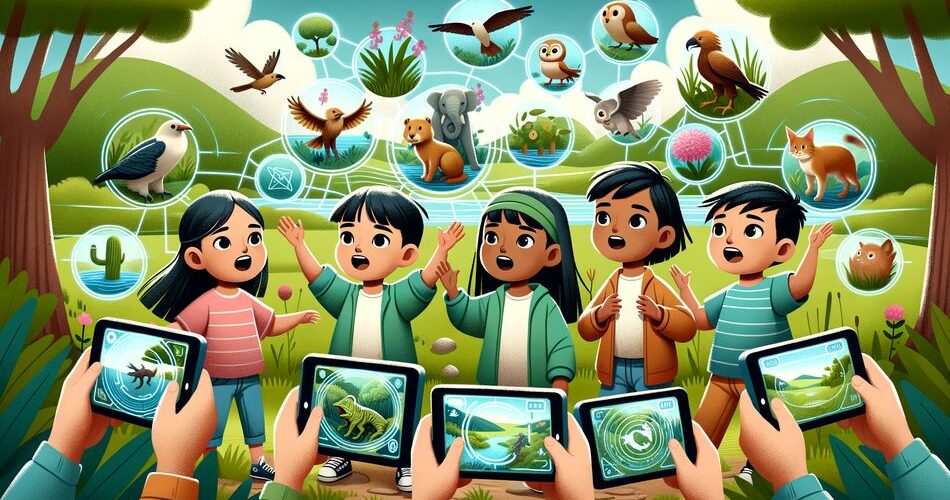Introduction
In today’s digital age, children often find themselves glued to screens for both learning and entertainment. Parents and educators struggle to compete with the allure of video games, apps, and online content. However, there’s a burgeoning technology that bridges the gap between the digital world and the great outdoors: Augmented Reality (AR). This innovative tool can play a pivotal role in rekindling children’s interest in nature, turning screen time into a gateway to green time.
The Digital Dilemma
While screens can be educational and entertaining, excessive screen time has been a growing concern among parents and health experts. Studies suggest that too much screen exposure can lead to issues such as decreased physical activity, poor social skills, and weakened emotional well-being. The challenge lies in reducing screen time without sacrificing the engagement and interactivity that digital platforms offer. This is where AR—the technology that overlays digital content onto the real world—steps in.
How AR Can Foster a Love for Nature
Augmented Reality can transform how children perceive and interact with nature. Here’s how AR can be a powerful tool to get kids excited about the environment:
1. Interactive Learning Experiences
Traditional methods of teaching kids about nature, such as textbooks and lectures, may not always capture their imagination. AR apps and devices can bring lessons to life by overlaying digital information onto natural settings. Imagine pointing a smartphone at a tree and seeing an interactive display of its lifecycle, the animals that depend on it, and its ecological significance. This immersive learning experience can make natural science exciting and engaging.
2. Gamification of Outdoor Activities
Gamification uses game design elements in non-game contexts to motivate and increase participation. AR can turn a simple hike in the woods into a thrilling adventure. For instance, apps can guide kids through scavenger hunts where they search for virtual treasures or identify various plants and animals. These games not only make outdoor activities fun but also educational, encouraging kids to explore their surroundings keenly.
3. Augmented Wildlife Encounters
Many children may never get the chance to see certain animals in their natural habitats. AR can change this by creating realistic, 3D models of wildlife that kids can observe up-close via their devices. Whether it’s a rare bird or a majestic elephant, these virtual encounters can foster a deeper appreciation for biodiversity and the need for conservation efforts.
4. Environmental Storytelling
Stories have an unparalleled ability to captivate young minds. With AR, children can follow interactive storytelling experiences set in natural environments. Picture a narrative where kids help an endangered species survive by learning about its habitat requirements and the threats it faces. Such stories can impart valuable lessons on empathy and environmental stewardship.
Bridging the Gap Between Technology and Nature
Integrating AR into outdoor experiences doesn’t mean children will be glued to their screens outdoors as well. On the contrary, AR can be a facilitator that sparks initial interest and then encourages real-world interaction. For example, an AR app might introduce a type of plant and then challenge kids to find and observe it in their local park. It becomes a tool that augments—not replaces—the genuine experiences of nature.
The Role of Parents and Educators
Parents and educators can leverage AR to rejuvenate children’s interest in nature. It starts with selecting the right AR apps and tools that align with educational goals and values. Encouraging family activities, such as weekend trips to nature reserves with AR-guided tours, can also be a delightful way to make the most of this technology. Educators can integrate AR into science curricula to provide hands-on learning experiences that textbooks alone cannot offer.
Conclusion
As we navigate the evolving landscape of digital technology and its impact on our lives, Augmented Reality stands out as a promising bridge to reconnect children with the natural world. By making learning interactive, outdoor activities gamified, wildlife encounters augmented, and environmental stories immersive, AR has the potential to transform screen time into green time. Parents and educators have a pivotal role in harnessing this technology to cultivate a generation that not only excels in the digital domain but also cherishes and protects the environment.
Incorporating AR into your child’s playtime and education can be a game-changer. It’s time to step into the future of learning and exploration, where the digital and natural worlds harmoniously coexist.

